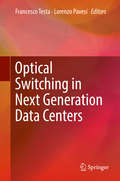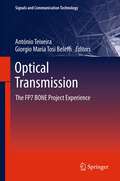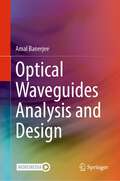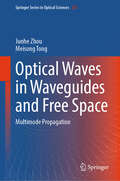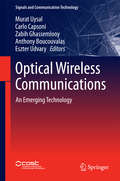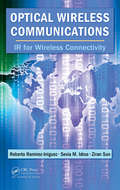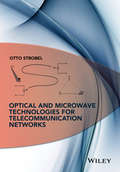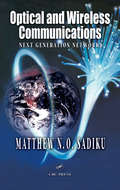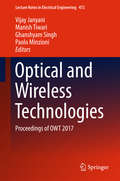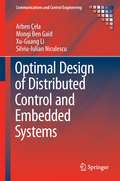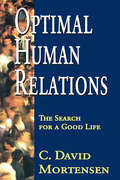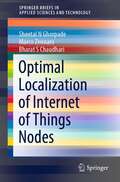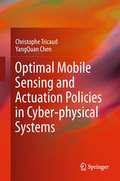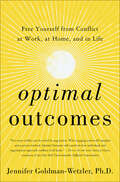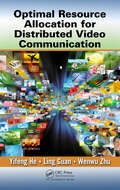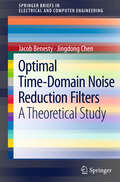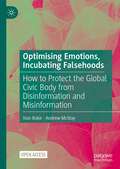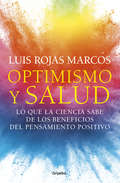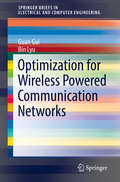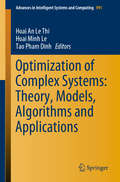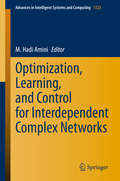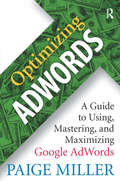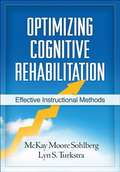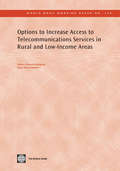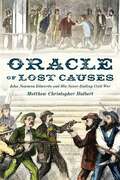- Table View
- List View
Optical Switching in Next Generation Data Centers
by Lorenzo Pavesi Francesco TestaThis book introduces the reader to the optical switching technology for its application to data centers. In addition, it takes a picture of the status of the technology and system architecture evolution and of the research in the area of optical switching in data center. The book is organized in four parts: the first part is focused on the system aspects of optical switching in intra-data center networking, the second part is dedicated to describing the recently demonstrated optical switching networks, the third part deals with the latest technologies developed to enable optical switching and, finally, the fourth part of the book outlines the future prospects and trends.
Optical Transmission
by António Teixeira giorgio maria tosi beleffiOptical Transmission represents a wide set of visions of researchers who are active in the actual research scene in Europe. An aggregate of highlights of research in transmission with a state of the art presented by the researchers who are driving it are presented. The trends on research are in this book presented by one of the widest networks of excellence put together in Europe in the field of optical networking (more than 40 Research institutions were involved). The readers will find a specialized readout of the current trends and status of transmission ranging from simulation to ultimate experimental results, from modulations to devices. A highlight of Optical Transmission is the introduction in a technical book a chapter on techno-economics, which drives the vision and field a little further. General reading could be made however is more suited for graduated users. The most important features of Optical Transmission are: wide vision on transmission related issues, state of the art and related trends and techniques; techno-economics of the field.
Optical Waveguides Analysis and Design
by Amal BanerjeeThis book offers readers a comprehensive, detailed analysis and treatment of optical waveguides (fiber, slab), an essential component of ultra-high bandwidth long, medium and short-haul telecommunication. The author describes an analysis scheme for optical waveguides that combines both geometric|ray optics and Maxwell’s equations-based classical electrodynamics. This unique approach enables readers to develop an intuitive understanding of this topic, starting with macro properties, e.g., V parameter of an optical fiber, and progressively refining the analysis to individual modes of propagation through an optical waveguide. An exhaustive set of diagrams highlight the key features of an optical waveguide property, such as acceptance angle, meridional and skew rays in an optical fiber, or signal attenuation and dispersion in an optical waveguide. The author also provides a set of ready-to-use, ANSI C executables (for both Linux and Windows) that enable the reader to e.g, determine the allowed propagation modes (even, odd TE|TM) of a graded, step index optical fiber and a slab waveguide.Offers readers a single-source reference to the analysis and design of optical waveguides;Begins with macro-level analysis of the properties of optical waveguides and dives deeply into details in a step-by-step manner, enabling readers to develop an intuitive understanding;Includes C language executables, along with optical waveguide analysis and design examples to demonstrate their use in context.
Optical Waves in Waveguides and Free Space: Multimode Propagation (Springer Series in Optical Sciences #251)
by Junhe Zhou Meisong TongThis book provides a thorough review of multi-mode propagation inside optical waveguides and free space, which is receiving particular attention for its promising applications in communications and sensing. At the heart of the book is the matter of how modes couple and interfere due to engineered or random index fluctuations, forming functional devices. The chapters cover topics such as multi-mode interference, coupled mode theory, and mode generation. Readers discover how a universal coupled mode theory can describe mode propagation, enabling stochastic analysis and avoiding time-consuming simulations. The book also delves into mode division multiplexing systems and digital signal processing (DSP) algorithm-enabled multiple-input multiple-output (MIMO) transmission in multi-mode systems. Researchers in the field of optical communications and for physicists and engineers will find this book to be invaluable. It offers a comprehensive review of multi-mode transmission systems' basic physics and applications, making it essential for anyone interested in advancing their understanding of this rapidly expanding field.
Optical Wireless Communications
by Murat Uysal Carlo Capsoni Zabih Ghassemlooy Anthony Boucouvalas Eszter UdvaryThis book focuses on optical wireless communications (OWC), an emerging technology with huge potential for the provision of pervasive and reliable next-generation communications networks. It shows how the development of novel and efficient wireless technologies can contribute to a range of transmission links essential for the heterogeneous networks of the future to support various communications services and traffic patterns with ever-increasing demands for higher data-transfer rates. The book starts with a chapter reviewing the OWC field, which explains different sub-technologies (visible-light, ultraviolet (UV) and infrared (IR) communications) and introduces the spectrum of application areas (indoor, vehicular, terrestrial, underwater, intersatellite, deep space, etc. ). This provides readers with the necessary background information to understand the specialist material in the main body of the book, which is in four parts. The first of these deals with propagation modelling and channel characterization of OWC channels at different spectral bands and with different applications. The second starts by providing a unified information-theoretic treatment of OWC and then discusses advanced physical-layer methodologies (including, but not limited to: advanced coding, modulation diversity, cooperation and multi-carrier techniques) and the ultimate limitations imposed by practical constraints. On top of the physical layer come the upper-layer protocols and cross-layer designs that are the subject of the third part of the book. The last part of the book features a chapter-by-chapter assessment of selected OWC applications. Optical Wireless Communications is a valuable reference guide for academic researchers and practitioners concerned with the future development of the world's communication networks. It succinctly but comprehensively presents the latest advances in the field.
Optical Wireless Communications: IR for Wireless Connectivity
by Roberto Ramirez-Iniguez Sevia M. Idrus Ziran SunOver the last three decades, interest in Infrared (IR) technology as a medium to convey information has grown considerably. This is reflected by the increasing number of devices such as laptops, PDAs, and mobile phones that incorporate optical wireless transceivers and also by the increasing number of optical wireless links available for indoor and
Optical and Microwave Technologies for Telecommunication Networks
by Otto StrobelThis is a self-contained book on the foundations and applications of optical and microwave technologies to telecommunication networks application, with an emphasis on access, local, road, cars, trains, vessels and airplanes, indoor and in-car data transmission as well as for long-distance fiber-systems and application in outer space and automation technology. The book provides a systematic discussion of physics/optics, electromagnetic wave theory, optical fibre technology, and the potential and limitations of optical and microwave transmission.
Optical and Wireless Communications: Next Generation Networks (Electrical Engineering and Applied Signal Processing Series)
by Matthew N.O. Sadiku<p>Optical and wireless technologies are being introduced into the global communications infrastructure at an astonishing pace. Both are revolutionizing the industry and will undoubtedly dominate its future, yet in the crowded curricula in most electrical engineering programs, there is no room in typical data communications courses for proper coverage of these "next generation" technologies.Optical and Wireless Communications: Next Generation Networks covers both types of networks in a unique presentation designed for a one-semester course for senior undergraduate or graduate engineering students. <p>Part I: Optical Networks covers optical fibers, transmitters, receivers, multiplexers, amplifiers, and specific networks, including FDDI, SONET, fiber channel, and wavelength-routed networks. Part II:Wireless Networks examines fundamental concepts and specific wireless networks, such as LAN, ATM, wireless local loop, and wireless PBXs. This section also explores cellular technologies and satellite communications. <p>Eventually, next generation networks will be as ubiquitous as traditional telephone networks, and today's engineering students must be prepared to meet the challenges of optical and wireless systems development and deployment. Filled with illustrations, examples, and end-of-chapter problems, Optical and Wireless Communications: Next Generation Networks provides a brief but comprehensive introduction to these technologies that will help future engineers build the foundation they need for success.</p>
Optical and Wireless Technologies: Proceedings Of Owt 2017 (Lecture Notes In Electrical Engineering #472)
by Ghanshyam Singh Vijay Janyani Manish Tiwari Paolo MinzioniThis book presents selected papers from 1st International Conference on Optical and Wireless Technologies, providing insights into the analytical, experimental, and developmental aspects of systems, techniques, and devices in these spheres. It explores the combined use of various optical and wireless technologies in next-generation networking applications, and discusses the latest developments in applications such as photonics, high-speed communication systems and networks, visible light communication, nanophotonics, and wireless and multiple-input-multiple-output (MIMO) systems. The book will serve as a valuable reference resource for academics and researchers across the globe.
Optimal Design of Distributed Control and Embedded Systems
by Silviu-Iulian Niculescu Xu-Guang Li Arben Çela Mongi Ben GaidOptimal Design of Distributed Control and Embedded Systems focuses on the design of special control and scheduling algorithms based on system structural properties as well as on analysis of the influence of induced time-delay on systems performances. It treats the optimal design of distributed and embedded control systems (DCESs) with respect to communication and calculation-resource constraints, quantization aspects, and potential time-delays induced by the associated communication and calculation model. Particular emphasis is put on optimal control signal scheduling based on the system state. In order to render this complex optimization problem feasible in real time, a time decomposition is based on periodicity induced by the static scheduling is operated. The authors present a co-design approach which subsumes the synthesis of the optimal control laws and the generation of an optimal schedule of control signals on real-time networks as well as the execution of control tasks on a single processor. The authors also operate a control structure modification or a control switching based on a thorough analysis of the influence of the induced time-delay system influence on stability and system performance in order to optimize DCES performance in case of calculation and communication resource limitations. Although the richness and variety of classes of DCES preclude a completely comprehensive treatment or a single "best" method of approaching them all, this co-design approach has the best chance of rendering this problem feasible and finding the optimal or some sub-optimal solution. The text is rounded out with references to such applications as car suspension and unmanned vehicles. Optimal Design of Distributed Control and Embedded Systems will be of most interest to academic researchers working on the mathematical theory of DCES but the wide range of environments in which they are used also promotes the relevance of the text for control practitioners working in the avionics, automotive, energy-production, space exploration and many other industries.
Optimal Human Relations: The Search for a Good Life
by C. David MortensenThis volume deals with the human desire to live the good life, defined as seeking that which "is good, optimal, or ultimately desirable." While there may be different ways of achieving this goal, the pathways are similar in some ways. In exploring the ways in which these paths cross, Mortensen asserts that an ability to sustain optimal human relations--that is, healthy communication, interpersonal compatibility, and prosocial influence--is a standard against which the good life can be measured. Optimal Human Relations explores the favorable conditions for human beings to live the best possible way of life imaginable; it both argues the case for and documents recent advances in the study of social influences on everyday life. Social influences help to develop an expansive sense of intrinsic motivation in daily encounters with others. While optimal relations are not easily achieved or maintained, it is through healthy relationships that one may pursue pleasure and happiness--even meaning, importance, and significance with valued companions. The cultivation of physical, emotional, intellectual, and spiritual health through these relations generates an enhanced sense of well-being, growth, and maturity. Mature individuals are more likely to maintain optimal relations by counting daily blessings more than lamenting routine burdens. This inspirational conception of "the good life" invites productive inquiry into the conditions responsible for the pursuit of optimal conditions, fulfilled expectations, and a rich, vital, way of life. It is through this lens that Mortensen measures the good life, pointing to these aspects of human communication as a litmus test of the relative importance of individualistic and collective orientations. Along the way, the reader discovers who and what we are in relation to the quality of the world in which we reside alongside those who journey with us.
Optimal Localization of Internet of Things Nodes (SpringerBriefs in Applied Sciences and Technology)
by Marco Zennaro Sheetal N Ghorpade Bharat S ChaudhariThis book is a practical resource for designing Internet of Things (IoT) networks and implementing IoT applications from the localization perspective. With the emergence of IoT, machine to machine communication, Industrial IoT, and other societal applications, many applications require knowledge of the exact location of mobile IoT nodes in real-time. As the IoT nodes have computational and energy limitations, it is a crucial research challenge to optimize the network's performance with the highest localization accuracy. Many researchers are working towards such localization problems. However, there is no single book available for the detailed study on IoT node localization. This book provides one-stop multidisciplinary solutions for IoT node localization, design requirements, challenges, constraints, available techniques, comparison, related applications, and future directions. Special features included are theory supported by algorithmic development, treatment of optimization techniques, and applications.
Optimal Mobile Sensing and Actuation Policies in Cyber-physical Systems
by Yangquan Chen Christophe TricaudA successful cyber-physical system, a complex interweaving of hardware and software with some part of the physical environment, depends on proper identification of the, often pre-existing, physical element. A bespoke "cyber" part of the system may then be designed from scratch. Optimal Mobile Sensing and Actuation Strategies in Cyber-physical Systems focuses on distributed-parameter systems the dynamics of which can be modelled with partial differential equations. These are very challenging to observe, their states and inputs being distributed throughout a spatial domain. Consequently, systematic approaches to the optimization of sensor location have to be devised for parameter estimation. The text begins by reviewing the field of cyber-physical systems and introducing background notions of distributed parameter systems and optimal observation theory. New research problems are then defined within this framework. Two important problems considered are optimal mobile sensor trajectory planning and the accuracy effects and allocation of remote sensors. These are followed up with a solution to the problem of optimal robust estimation. Actuation policies are then introduced into the framework with the purpose of improving estimation and optimizing the trajectories of both sensors and actuators simultaneously. The large number of illustrations within the text will assist the reader to visualize the application of the methods proposed. A group of similar examples are used throughout the book to help the reader assimilate the material more easily. The monograph concentrates on the use of methods for which a cyber-physical-systems infrastructure is required. The methods are computationally heavy and require mobile sensors and actuators with communications abilities. Application examples cover fields from environmental science to national security so that readers are encouraged to link the ideas of cyber-physical systems with their own research.
Optimal Outcomes: Free Yourself from Conflict at Work, at Home, and in Life
by Jennifer Goldman-Wetzler“This hands-on book is full of reflection exercises to help you spot the hidden patterns in your regular clashes and learn how to defuse them.” —Adam Grant, #1 New York Times–bestselling author A founding CEO and his top salesperson are engaged in a heated clash over her compensation package.A mother and daughter are locked in a nasty cycle of blame and attack.A high-profile executive team is struggling with aggressive political infighting.In all these cases, every effort to talk it out has been unsuccessful.Where can you turn when your attempts to resolve conflict fail? Most approaches emphasize collaboration. You are supposed to sit down, calmly talk through your differences, and find a solution. But what if nothing seems to work, no matter what you do?When situations resist resolution, the Optimal Outcomes Method teaches us conflict freedom.This innovative method is based on Dr. Jennifer Goldman-Wetzler’s training at the Program on Negotiation at Harvard Law School, two decades as a consultant to Fortune 500 and high-growth CEOs and senior teams, grassroots work with Middle East leaders, US government-funded research on terrorism, and her popular course at Columbia University. In Optimal Outcomes, she reveals eight groundbreaking practices proven to help people everywhere free themselves from conflict.With inspiring stories from clients, students, and Dr. Goldman-Wetzler’s own life lighting the way, you’ll learn to observe complex situations with clarity, access your shadow values (things you really care about but have been unwilling to admit), and take bold, simple, surprising action. Applying the practices, you’ll reach your Optimal Outcome—which may be vastly different from what you originally imagined, but more satisfying than you ever dreamed possible.
Optimal Resource Allocation for Distributed Video Communication
by Ling Guan Wenwu Zhu Yifeng HeFocusing on resource optimization for distributed video and multimedia communications, this book examines four applications in optimal resource allocations with distributed algorithms, including problem formulation, theoretical analysis, and simulation results. Suitable for both industry practitioners and academics, it introduces the characteristics, recent advances, and current challenges in distributed systems as well as a solutions framework to tackle those challenges. Discussing cutting-edge topics such as the theory of convex optimization and the development of a distributed algorithm using dual decomposition, the book concludes with open issues to stimulate further learning.
Optimal Time-Domain Noise Reduction Filters
by Jacob Benesty Jingdong ChenAdditive noise is ubiquitous in acoustics environments and can affect the intelligibility and quality of speech signals. Therefore, a so-called noise reduction algorithm is required to mitigate the effect of the noise that is picked up by the microphones. This work proposes a general framework in the time domain for the single and multiple microphone cases, from which it is very convenient to derive, study, and analyze all kind of optimal noise reduction filters. Not only that all known algorithms can be deduced from this approach, shedding more light on how they function, but new ones can be discovered as well.
Optimising Emotions, Incubating Falsehoods: How to Protect the Global Civic Body from Disinformation and Misinformation
by Andrew McStay Vian BakirThis open access book deconstructs the core features of online misinformation and disinformation. It finds that the optimisation of emotions for commercial and political gain is a primary cause of false information online. The chapters distil societal harms, evaluate solutions, and consider what must be done to strengthen societies as new biometric forms of emotion profiling emerge. Based on a rich, empirical, and interdisciplinary literature that examines multiple countries, the book will be of interest to scholars and students of Communications, Journalism, Politics, Sociology, Science and Technology Studies, and Information Science, as well as global and local policymakers and ordinary citizens interested in how to prevent the spread of false information worldwide, both now and in the future.
Optimismo y salud: Lo que la ciencia sabe de los beneficios del pensamiento positivo
by Luis Rojas MarcosEn este nuevo libro del reconocido psiquiatra Luis Rojas Marcos, aprenderemos que sentir y pensar en positivo es una inversión sumamente rentable para desarrollar al máximo las posibilidades de vivir sanos y felices. Además de conocer los ingredientes que distinguen el optimismo del pesimismo, explorar las fuerzas que forjan nuestro temperamento e identificar los venenos más dañinos, el autor describe eficaces estrategias para fomentar el positivismo al tiempo que examina la influencia del optimismo en las relaciones con otras personas, así como en la salud y el trabajo. Un texto indispensable para el momento actual. «A lo largo de los años, tanto en mi vida personal como en el mundo de la medicina, la psiquiatría y la salud pública, he tenido oportunidad de confirmar, en incontables ocasiones, que la forma de percibir e interpretar las situaciones que nos plantea la vida ejerce un inmenso poder sobre nuestras emociones, decisiones, conductas y juicios. Para disfrutar de una vida saludable y completa, no basta con curar los males que nos aquejan; es igualmente importante conocer y fortificar los aspectos favorables de nuestra naturaleza, que nos ayudan a motivarnos, a superar los retos y a alcanzar nuestras metas.»LUIS ROJAS MARCOS
Optimization for Wireless Powered Communication Networks (SpringerBriefs in Electrical and Computer Engineering)
by Guan Gui Bin LyuThis SpringerBrief introduces the basics of wireless powered communication networks (WPCNs). In particular, the background and concept of WPCNs are briefly discussed. Moreover, this brief provides an extensive study of the recent developments in this area from an optimization perspective. Wireless powered communication network (WPCN) is a new network paradigm for IoT, where wireless devices (WDs) are powered by radio frequency (RF) based wireless power transfer (WPT) to eliminate the need for recharging or replacing the batteries manually and to prolong their lifetime.In this context, the brief also discusses some optimization problems for state-of-the-art scenarios of wireless powered communication networks.The target audiences for this SpringerBrief are researchers, engineers, and undergraduate and graduate-level students, who are studying or working in wireless powered communication networks and its performance optimization.
Optimization of Complex Systems: Theory, Models, Algorithms and Applications (Advances in Intelligent Systems and Computing #991)
by Hoai An Le Thi Hoai Minh Le Tao Pham DinhThis book contains 112 papers selected from about 250 submissions to the 6th World Congress on Global Optimization (WCGO 2019) which takes place on July 8–10, 2019 at University of Lorraine, Metz, France. The book covers both theoretical and algorithmic aspects of Nonconvex Optimization, as well as its applications to modeling and solving decision problems in various domains. It is composed of 10 parts, each of them deals with either the theory and/or methods in a branch of optimization such as Continuous optimization, DC Programming and DCA, Discrete optimization & Network optimization, Multiobjective programming, Optimization under uncertainty, or models and optimization methods in a specific application area including Data science, Economics & Finance, Energy & Water management, Engineering systems, Transportation, Logistics, Resource allocation & Production management. The researchers and practitioners working in Nonconvex Optimization and several application areas can find here many inspiring ideas and useful tools & techniques for their works.
Optimization, Learning, and Control for Interdependent Complex Networks (Advances in Intelligent Systems and Computing #1123)
by M. Hadi AminiThis book focuses on a wide range of optimization, learning, and control algorithms for interdependent complex networks and their role in smart cities operation, smart energy systems, and intelligent transportation networks. It paves the way for researchers working on optimization, learning, and control spread over the fields of computer science, operation research, electrical engineering, civil engineering, and system engineering. This book also covers optimization algorithms for large-scale problems from theoretical foundations to real-world applications, learning-based methods to enable intelligence in smart cities, and control techniques to deal with the optimal and robust operation of complex systems. It further introduces novel algorithms for data analytics in large-scale interdependent complex networks. • Specifies the importance of efficient theoretical optimization and learning methods in dealing with emerging problems in the context of interdependent networks • Provides a comprehensive investigation of advance data analytics and machine learning algorithms for large-scale complex networks • Presents basics and mathematical foundations needed to enable efficient decision making and intelligence in interdependent complex networks M. Hadi Amini is an Assistant Professor at the School of Computing and Information Sciences at Florida International University (FIU). He is also the founding director of Sustainability, Optimization, and Learning for InterDependent networks laboratory (solid lab). He received his Ph.D. and M.Sc. from Carnegie Mellon University in 2019 and 2015 respectively. He also holds a doctoral degree in Computer Science and Technology. Prior to that, he received M.Sc. from Tarbiat Modares University in 2013, and the B.Sc. from Sharif University of Technology in 2011.
Optimizing AdWords: A Guide to Using, Mastering, and Maximizing Google AdWords
by Paige MillerOptimizing AdWords provides the information marketers and future marketers need to harness the power of the Google’s AdWords search engine marketing applications. It provides a big picture overview of the AdWords system, helping businesses and individuals decide how to advertise products or their clients’ products. Optimizing AdWords was written for those at every rung of the ladder, from Marketing Directors to small business owners to students just starting out in marketing. This volume is organized around accessibility and ease of use. Author Paige Miller, co-founder of MultiPlanet Marketing Inc., has written this how-to guide to be super easy and fast to read and absorb. It moves you straight to the salient points of the text, allowing readers to take on AdWords in overview before coming back and collecting the finer details. Chapters 1 through 4 cover the basics, while the rest serve as a reference readers can come back to in building and growing campaigns. Using this book, professional marketers and other business professionals can utilize Google AdWords and optimize it for existing marketing strategies, or create whole new campaigns based around the system. Today, given the level of competition for ad positions on Google search pages, success hinges on understanding Google AdWords well enough to outperform competition. This book will provide readers with the knowledge necessary to master Google AdWords.
Optimizing Cognitive Rehabilitation
by Lyn Turkstra Mckay SohlbergRehabilitation professionals face a key challenge when working with clients with acquired cognitive impairments: how to teach new skills to individuals who have difficulty learning. Unique in its focus, this book presents evidence-based instructional methods specifically designed to help this population learn more efficiently. The expert authors show how to develop, implement, and evaluate an individualized training plan. They provide practical guidelines for teaching multistep procedures, cognitive strategies, the use of external aids, and more. User-friendly features include 17 sample worksheets and forms; blank forms can be downloaded and printed in a convenient 8 1/2" x 11" size.
Options to Increase Access to Telecommunications Services in Rural and Low-Income Areas
by Juan Navas-Sabater Arturo Muente-KunigamiTelecommunications sector policy-makers and regulators have a wide range of instruments available to them that can be used to increase access to telecommunications services in rural and low-income areas. The paper provides a review of these instruments, evaluating them against a set of criteria. It then goes on to identify a number of them that are worthy of further consideration by policy-makers and regulators while demonstrating that the effectiveness of the identified instruments can be greatly enhanced by the establishment of a conducive legal, regulatory and institutional framework. The paper concludes by confirming that while no single instrument taken in isolation can provide a full solution to universal access, a mix of the measures identified can be devised to achieve specific policy objectives in a particular country environment.
Oracle of Lost Causes: John Newman Edwards and His Never-Ending Civil War
by Matthew Christopher HulbertJohn Newman Edwards was a soldier, a father, a husband, and a noted author. He was also a virulent alcoholic, a duelist, a culture warrior, and a man perpetually at war with the modernizing world around him. From the sectional crisis of his boyhood and the battlefields of the western borderlands to the final days of the Second Mexican Empire and then back to a United States profoundly changed by the Civil War, Oracle of Lost Causes chronicles Edwards&’s lifelong quest to preserve a mythical version of the Old World—replete with aristocrats, knights, damsels, and slaves—in North America. This odyssey through nineteenth-century American politics and culture involved the likes of guerrilla chieftains William Clarke Quantrill and &“Bloody Bill&” Anderson, notorious outlaws Frank and Jesse James, Confederate general Joseph Orville Shelby, and even Emperor Maximilian I and Empress Charlotte of Mexico. It is the story of a man who experienced Confederate defeat not once but twice, and how he sought to shape and weaponize the memory of those grievous losses. Historian Matthew Christopher Hulbert ultimately reveals how the Civil War determined not only the future of the vast West but also the extent to which the conflict was part of a broader, international sequence of sociopolitical uprisings.
